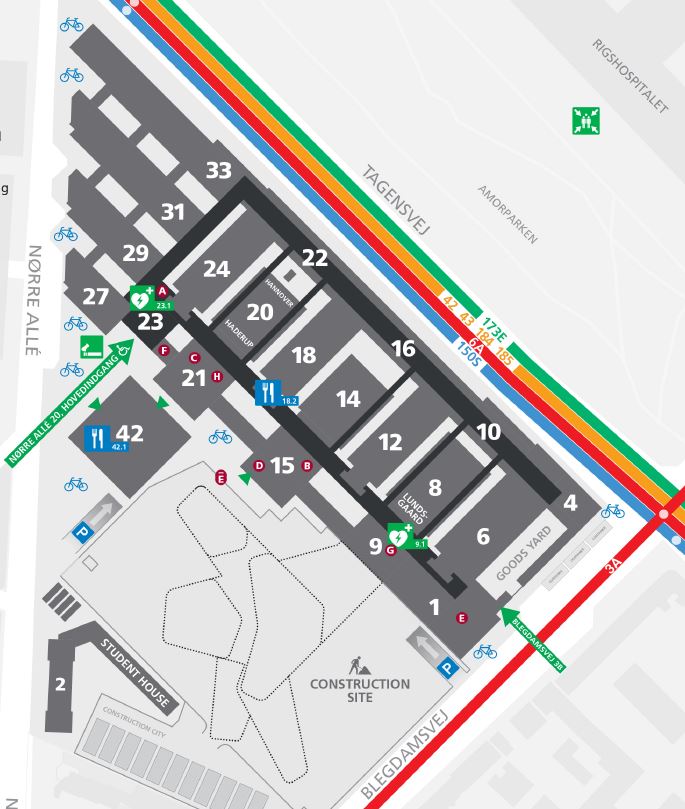FENS Satellite 2016
WELCOME TO:
Interneuron Synaptic Plasticity - From Mechanism to higher Brain Function
A satellite event of the FENS Forum 2016, Copenhagen
Date: July 1 (11 a.m. to 6 p.m.)
Venue:
University of Copenhagen, Faculty of Health
Hannover Auditorium
Nørre Allé 20
2200 Copenhagen N
(Maps and transportation see below.)
Short description:
A fundamental feature of the brain is its ability to acquire and store novel information, which enables the individual organism to adapt to its changing environment. Learning and memory are dependent on the capacity of nerve cells to change the efficacy of their communication points, the synapses. These plastic changes depend on correlated neuronal activity of communicating neurons and are expressed as long-term potentiation (LTP) as well as longterm depression (LTD) of synaptic transmission. Synaptic plasticity had first been proposed and subsequently demonstrated at glutamatergic synapses in networks of excitatory principal cells. Since then, synaptic plasticity in excitatory networks has been increasingly well documented, and is widely accepted today as the main neural mechanism underlying learning and memory in the brain. In contrast, plasticity in GABAergic inhibitory interneurons (INs) was controversial for a long time and its functional contribution to higher brain function remained speculative. However, a number of recent studies demonstrated that plastic changes also take place at glutamatergic synapses onto INs. Moreover, these investigations revealed an unexpected variety in the conditions and forms of synaptic plasticity in these cells, raising the possibility that plasticity in INs could contribute to information processing in a very versatile, cell type- and synapse-specific manner. It further indicates that changes in the properties of INs will have a wide-range impact on neuronal network function and thus may underlie major brain disorders.
In the satellite event 10 speakers from 4 different countries will give a state of - the-art update on the molecular mechanisms underlying plastic changes in interneurons and the role of IN synaptic plasticity on network activity, learning and memory-relevant behaviour.
Programm:
11:00 – 11:30
Welcome and opening remarks.
Marlene Bartos (University Freiburg Germany):
Synaptic plasticity in Parvalbumin-expressing fast-spiking interneurons of the dentate gyrus.
11:30 – 12:00
Jörg Geiger, (Charité Berlin, Germany):
Late developing plasticity of interneuron excitation in the mouse motorkortex.
12:00 – 12:30
Imre Vida, (Charité Berlin, Germany):
Differential GABAB receptor-mediated control of inhibitory interneuron types in hippocampal networks.
12:30 – 13:30 Lunch Break
13:30 – 14:00
Desiree Loreth/ Akos Kulik, (University Freiburg Germany):
Nano-scale organization and dynamics of dendritic CaV 1.2 Ca ²+ channels.
14:00 – 14:30
Peer Wulff, (University Kiel, Germany):
Structural plasticity of Parvalbumin-expressing cells in the dentate gyrus.
14:30 – 15:00
James Poulet, (Charité Berlin, Germany):
Sensorimotor transformation in the mouse forepaw system.
15:00 – 15:30
Jozsef Csicsvari, (IST Klosterneuburg, Austria):
Activity-dependent regulations of interneuron circuits.
15:30– 15:45 Coffee break
15:45 – 16:30
Chris McBain (NIH Bethesda, USA):
NMDARs on neurogliaform cells control cell and circuit maturation.
16:30 – 17:15
Daniel Feldman (University of California, Berkeley, USA):
Inhibitory circuit mechanisms for rapid homeostasis in somatosensory cortex.
17:15 – 18:00
Dimitri Kullmann (UCL London, UK):
Two forms of LTP in hippocampal interneurons.
We are looking forward seeing you!
HOW TO GET THERE:
Public transportation
If you come to Copenhagen via Kastrup Airport you can easily reach the Faculty of Health at the Panum Institute by public transportation. You can take the Metro from the airport. It takes 18 minutes to reach Nørreport station. From the airport you can also take the regional train, which brings you to the Central station in 20 minutes and from the central station you go to Nørreport station by S-train. Coming from Nørreport Station you can take the bus line 6A, 42, 42, 184, 185 and 150S to Nørre Campus.
Enter the buidling via the main entrance (gree arrow saying "Hovedindgang", map below). The "Hannover auditorium" is number 22!



